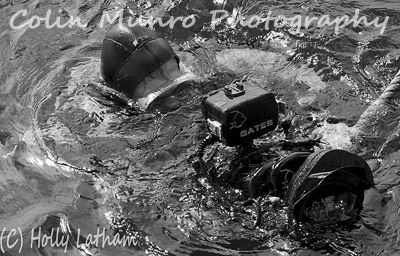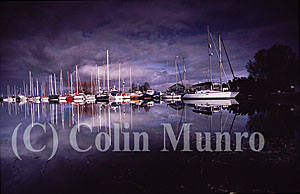
Mussels, Mytilus edulis, and Obelia indivisa hydroids on an old pier leg
I took my first underwater pictures bimbling about between the uprights and cross-members of an old wooden pier. That was with second-hand Nikonos III, a set of extension tubes and a Sunpak 28 strobe. I’ve probably still got it somewhere. Underwater photography has moved on a long way since then but I still love exploring old wooden piers and the opportunities they present for macro-photography. The uprights are normally festooned with filter-feeding life: hydroids and sea squirts often forming dense carpets. Dahlia and Sagartia anemones add a splash of colour. To me the beauty of macro-photography is that the basic skills can be learned quite quickly and sharp, colour-saturated images can be created even in our often quite turbid coastal waters. There is also the fun of exploring and discovering small creatures in crevices and overhangs; the joys of being a kid again for an hour or so. Each pier or jetty presents its own particular hazard. This can range from watching that a dropping tide doesn’t leave you trying to clamber up the bottom rungs of a badly corroded and rickety old ladder when trying to exit the water, to avoiding being knocked unconcious by the weapons grade halitosis of betching bull sealions as they lie flopped across the jetty cross members. But the pleasures tend to remain the same; hunting for that perfect patch of jewel anemones or symmetrical cluster of featherduster tubeworms.
The above pic was taken on the legs of a fairly tide swept pier in Southern Ireland. Large, fat mussels gaped in the rich feeding currents and between them bright orange Obelia hydroids swayed like tiny sunflowers. The trick with all macro-photography (and indeed much temperate water photography) is to slow down and look closely at what is literally just in front of your nose. The other pleasure that often comes from macro-photography is that one often discovers new things in the image that you never saw at all when composing the photograph. To take the above example; I was completely oblivious to the tiny crustacean scuttling about between the Obelia polyps, only noticing it once I had developed the film (yes, this is a film image), scanned the slide and viewed it on my laptop. This still applies with our current top-end DSLRs. Although lcd screens are improving all the time, small details are only revealed when the image is downloaded and viewed on a much larger screen.
Underwater Photography Workshop
For those interested I will be running a one day workshop, an introduction to underwater photography, in Exeter, Devon next month (6th March). This is intended for those relatively new to underwater photography looking to acquire a good grounding in the theory and practical skills, or possibly decide which system they are going to go for. There are still a few places left as I write this. For more info go to: Introduction to underwater photography workshop


